For many practitioners, fitting the compromised cornea with a contact lens seems a daunting prospect and is not routinely taken on. The UltraHealth and Elements lenses designed for irregular fitting are just a couple of the myriad options available for fitting irregular corneas and this will be demonstrated within this article. However, I hope the article will also convince you that there is a place for the hybrid lens when fitting the uncomplicated eye.
One of the benefits of a hybrid is that it does not need a toric surface to correct corneal astigmatism of any level. It uses the tear lens optics naturally provided by the rigid gas permeable (RGP) central portion, and is not dependent on lens rotation or stabilisation to correct the astigmatism. It, therefore, offers a useful alternative for the effective correction of astigmatic patients in any contact lens clinic.
RGP contact lenses have decreased in popularity. This is due to perceived complexities in fitting, initial comfort issues and the occasional irritation of environmental debris under the lenses; all things not to be expected with soft lenses. Offering the quality of vision of an RGP, combined with the comfort of a soft lens, leads to the hybrid being a valuable option in any high street practice’s product portfolio.
A Brief History
The idea behind the hybrid contact lens is not a new one. The first hybrid was the Saturn II from Precision Cosmet; it was invented by Erikson and Neogi and gained FDA approval and appeared on the market in 1984. Sola Barnes Hind purchased Precision Cosmet in 1986 and released the next generation hybrid, the Softperm, in 1989. Subsequently, Ciba Vision, following its acquisition of Pilkington Barnes-Hind, marketed these lenses. A combination of poor durability, reproducibility and fitting challenges, including lens adherence, meant these lenses never became mainstream and were largely used to troubleshoot keratoconic patients with a history of intolerance with RGPs.
It was not until early last decade that more modern designs, made by new manufacturing techniques and with superior bonding technologies for the junction of the RGP and soft materials, started to appear on the market. SynergEyes Inc (based in California) was singlehandedly responsible for the rebirth of the modern hybrid when, in 2005, it launched two lenses; SynergEyes A, for the correction of myopia and hyperopia with moderate to high astigmatism, and the KC lens, for the correction of irregular corneas and keratoconus. These first-generation lenses proved to be both durable and popular, especially in the hospital-fitting arena, offering clear vision (from the RGP component) and superior comfort (from the soft component) to patients requiring more challenging fits. Indeed, these lenses are still widely used today. The timeline of the subsequent development of the SynergEyes range of hybrid lenses can be seen in figure 1.
| 2005 | SynergEyes A, KC and PS launched |
| 2009 | SynergEyes ClearKone reverse geometry vaulting lens introduced |
| 2010 | Duette and Duette Multifocal (hyper Dk RGP/high Dk sihy skirt) appear |
| 2013 | UltraHealth (hyper Dk RGP/High Dk sihy skirt) laucnhed |
| 2014 | Duette Progressive CN and empirical fitting for the Duette range introduced |
| 2015 | UltraHealth FC introduced for oblate corneas |
| 2017 | SynergEyes launched in UK (supplier Positive Impact) |
| 2018 | Duette Progressive CD launched |
| 2019 | Duette Progressive CD becomes Optician Awards Contact Lens product of the Year |
| 2021 | SynergEyes iD launches in SV and BHVI EDOF |
Figure 1: Timeline of hybrid lens development
Currently in the UK, there are just two manufacturers offering hybrid lenses. The most recent designs and materials, with high Dk RGP centres and silicone hydrogel skirts, are outlined in table 1. A typical design is shown in figure 2
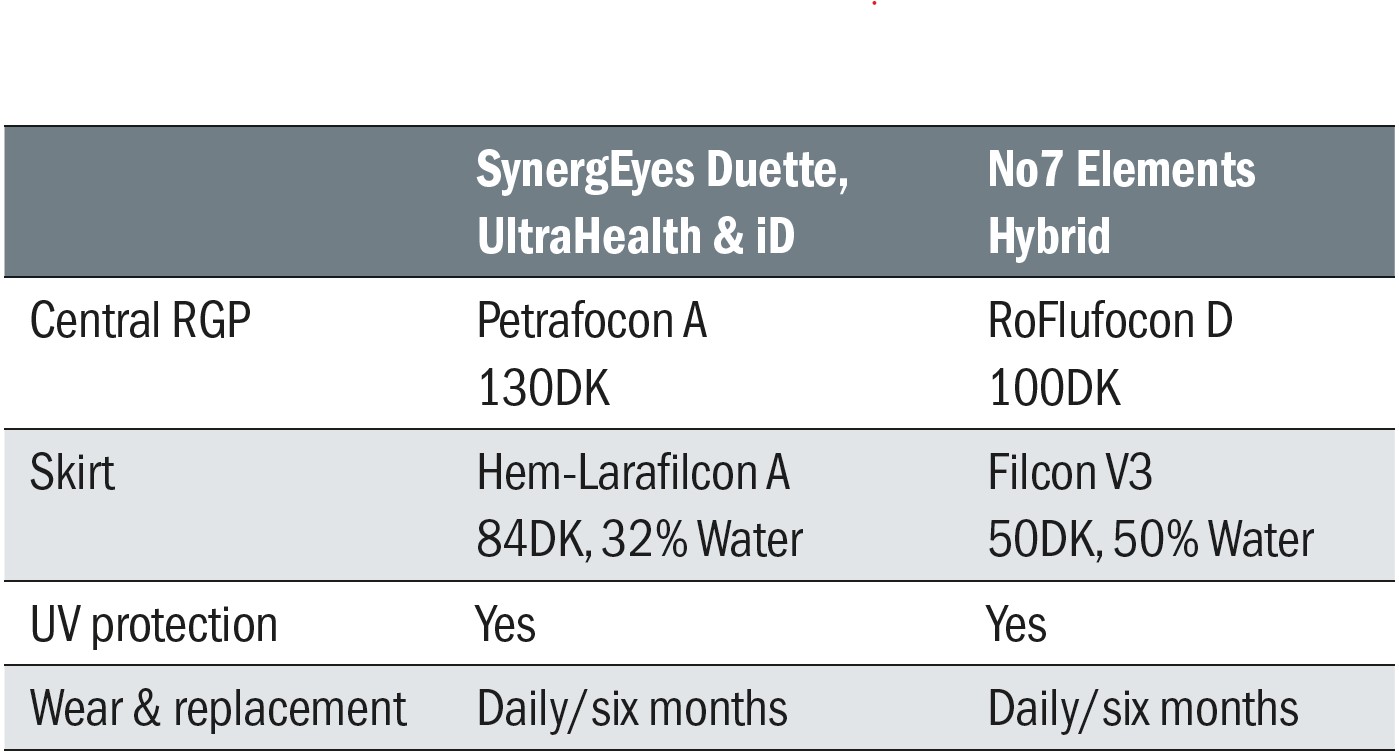 Table 1: Recent hybrid designs and materials
Table 1: Recent hybrid designs and materials
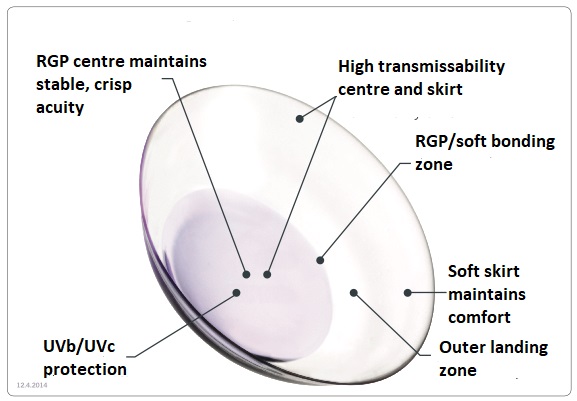
Figure 2: Typical design of a generic hybrid contact lens
Hybrid Designs
Broadly, there are now two approaches to supply of the modern hybrids:
- The manufacturer provides approved laboratories with buttons (in this case of the hybrid material) in order for the lab to manufacture their own designs
- The manufacturer develops, designs and manufactures its own proprietary lenses, more in keeping with the approach of the larger soft lens companies
The Elements Hybrid contact lens (No7 Contact Lenses) is the EyeBrid lens design, first developed by LCS laboratories in France. LCS launched the Eyebrid lens into the French market in 2012 and it is supplied to laboratories who may then use the design and materials or, in the case of the Elements Hybrid, the material alone in order that the manufacturing laboratory can design their own lenses. No7 Contact Lenses have multiple designs available for the regular and irregular cornea.
The EyeBrid Silicone hybrid is manufactured from the following two materials:
- Centre; Optimum 100 RGP material (from Contamac)
- Skirt; Definitive silicone hydrogel material
The two materials are assembled using a patented process described by the company as polymeric suture technology.
SynergEyes most recent lenses use proprietary materials and patented bonding technology, where the silicone hydrogel material is covalently bonded with the GP portion of the lens. A covalent bond forms when the difference between the electronegativities of two atoms is too small for an electron transfer to occur to form ions. Shared electrons located in the space between the two nuclei are called bonding electrons. The bonded pair is the ‘glue’ that holds the atoms together in molecular units.
In terms of durability, a poster at the 2017 BCLA Clinical Conference presented results from a trial that showed the covalent bond between centre and skirt could withstand over 10 Newtons of force before failure occurred, elongating the lens by 300% in the process (see figure 3). Interestingly, the failure, when it did occur, was not in the bond between the two materials but instead was due to the silicone hydrogel material tearing at the point where the clamp secured the lens. After many tests, mechanical failure occurred after an average of 8.5N force was exerted, while there was a 0% junction failure rate.1
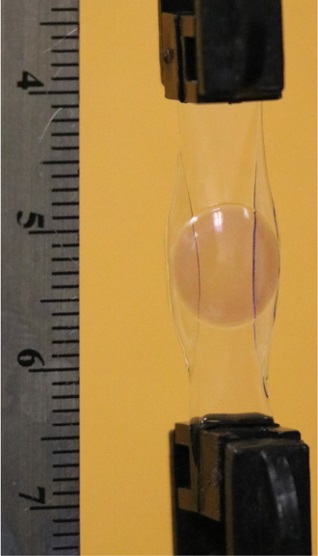 Figure 3: Testing the strength of a hybrid lens
Figure 3: Testing the strength of a hybrid lens
So, it would appear that one of the key criticisms of the earlier hybrid lenses, that of poor durability, appears to have been addressed.
Patient Selection
Hybrid lenses are often viewed as purely for irregular corneal fitting. However, it has been argued by many for some time that these lenses are ideal for the regular corneal astigmat and capable of covering cylindrical powers up to 6.00DC. What makes the hybrid attractive in such cases is excellent stability of acuity, due to the action of the tear lens, with the comfort of a soft lens due to the skirt.
Fitting Philosophies
The fitting philosophies for the different hybrid contact lenses differ.
The Elements lens
The Elements lens has two different diameter gas permeable portions, one for regular and another for irregular fits. It is available in both spherical and toric formats, as well as multifocal options. There are also several skirt designs available to optimise the fitting.
SynergEyes Duette
The SynergEyes Duette family of lenses is designed for regular corneas, although they are often used successfully for correcting early keratoconics. The lenses come in both a single vision and a progressive design, the latter available in a centre near and centre distance format.
The Progressive CD is licenced for presbyopia, but has been used for myopia management of astigmatic myopes, and has a wide range of available adds (+0.75DS to +5.00DS) and a configurable optic zone diameter, ranging from 1.8 to 4.0mm in 0.1mm steps. This gives the practitioner the ability to correct corneal cylinders completely without the complication of a custom soft toric multifocal (see the case studies later).
Duette lenses are fitted totally empirically, based upon the k readings, being fitted slightly steeper than the flattest K, to create the tear lens without any touch, and an accurate horizontal visible iris diameter (HVID), to determine the correct skirt. This author would like to linger on this point for a moment; the HVID is often overlooked in terms of its importance. An accurate measurement can improve patient outcome and minimise chair time, but sadly HVID is often viewed as an afterthought by many, and is measured at best to just ±0.5mm accuracy and as identical in both eyes. With the use of a topographer, if available, or judicious use of a camera (slit lamp or smartphone) with a ruler held before the patients’ eye and a quick zoom into the picture, you can very quickly and easily get an accurate result.
SynergEyes UltraHealth
For irregular corneas, SynergEyes have developed a family of vaulting design lenses, namely the UltraHealth and the UltraHealth FC (FC referring to a flat curve for oblate corneas) lenses. In the past, these were fitted using a fitting set to determine the clearance over the irregularity, but can now be ordered empirically too. These lenses are often overlooked by practitioners who instead fit scleral or mini-scleral lenses. However, the UltraHealth offers some advantages over a scleral lens:
- The UltraHealth ‘lands’ more easily with conjunctival irregularities, such as pinguecula
- Settling back; conjunctival compression is less with UltraHealth, typically around 40-60μ compared with around 150μ for a scleral lens
- The hybrid has a much reduced clearance (see figure 4)
- The hybrid allows tear flow as it does not seal off, so reducing post-lens tear layer fogging
- Normalisation; never underestimate how a patient may worry about wearing something ‘odd’ when compared to their peers or family. UltraHealth handles similarly to a soft lens and uses standard soft lens solution systems
 Figure 4: Anterior OCT of the UltraHealth lens in situ demonstrating reduced clearance
Figure 4: Anterior OCT of the UltraHealth lens in situ demonstrating reduced clearance
Recently, the amount of time we spend with a patient has become more important than ever and limiting the number of visits is key, and not just from a financial point of view. To this end, SynergEyes has developed an empirical process for fitting UltraHealth and UltraHealth FC lenses, calculating the sag required from Topographical or Pentacam maps, moving away from the traditional methods of trial lens usage and fitting sets that need maintaining (see case study later).
SynergEyes iD
SynergEyes iD was launched in the US in January 2021 and is now available here in the UK. This lens is a further development of the Duette and Duette Progressive lenses and is available in single vision and the Brien Holden Vision Institute extended depth of focus design.
Both lens designs have a larger 8.5mm optic zone, with BOZRs available in 0.01mm steps (hence iD which stands for ‘individual design’), along with a new linear skirt design available in 12 different fittings.
Current multifocal RGP contact lenses can seem daunting to fit due to the nature of increased movement. However, the soft skirt of SynergEyes iD centres the lenses easily while correcting the corneal astigmatism at the same time. Like Duette and Elements, these lenses will be ordered empirically using the patient’s K readings, HVID and spectacle Rx. Due to the accuracy of manufacture, the more accurate the clinical measurements, the better the patient outcomes.
Application and Removal of Hybrid Lenses
I am often told that hybrid lenses are difficult for both the patient and practitioner to handle, with lenses adhering and being irremovable. I would say that the handling is indeed different, but it is not difficult.
Insertion of a hybrid by a patient should be similar to that of any previously worn soft or RGP lens. It is recommended that a drop of unpreserved solution be applied to the lens before placing on the eye. Due to the more rigid nature of the lens, some people find it easier to support the lens with more than one finger, lean over the lens and place it onto the eye from below. It is slightly different in the case of the UltraHealth lens. Due to the vaulting nature of this product, it should be filled in the same way as a small scleral design to ensure no air bubbles become trapped under the lens.
For removal, with all SynergEyes lenses, one of the key aids to removing is very dry fingers. Fingers should be dried with a lint free tissue or towel. Place dry fingertips at the five o’clock and seven o’clock positions on the lens and apply slight pressure. The action can be described as forming a ‘duck bill’ finger position (figure 5). When a pinch is applied to the inferior portion, the soft skirt lifts slightly, allowing air to go under the lens. As the skirt keeps the RGP away from the cornea, all surface tension is broken, and the lenses can be removed easily. It can be beneficial to use a single ply of tissue to cover the fingertips and provide a little more grip, certainly to build confidence when first handling. For most, this very quickly becomes unnecessary.
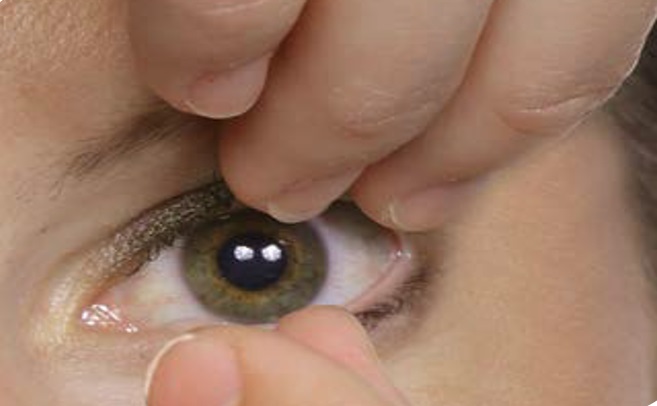 Figure 5: Forming a ‘duck bill’ finger position to remove a hybrid lens
Figure 5: Forming a ‘duck bill’ finger position to remove a hybrid lens
No7 advise against pinching their lens and prefer the alternative techniques, including the ‘eyelid’ or ‘scissor’ methods; similar to removing an RGP by trapping the lens between the lid margins. An RGP lens removal tool applied to the soft skirt/RGP junction can also be employed, lifting the skirt from the bottom first, but this should not be necessary.
Lens Care and Replacement
All readily available soft lens chemical disinfection systems can be used with both the Elements and SynergEyes hybrid lenses. Most patients’ preference would be for multipurpose solutions over hydrogen peroxide and, provided a good rub and rinse method is applied, stronger cleaners are not usually necessary. However, should more effective cleaning be required, a soft lens daily cleaner can be used. Soft lens comfort drops can be used as necessary; ideally preservative free and instilled into the bowl of the lens before application. RGP lens care solutions are contraindicated. The recommended replacement schedule is every six months.
Case records
Case #1: Duette Progressive for a regular corneal astigmatic presbyope
Patient SM has worn XR Soft Toric (both SV and Multifocal). Has never been happy with VA or stability of vision. Rigid lens history unknown.
- Spec Rx
- R -1.00/-5.75 x 5 (VA 6/6) Add +1.75 (N5)
- L -0.50/-6.50 x180 (VA 6/6-) Add +1.75 (N6)
- K readings
- R 8.30 along 7 x 7.38 along 97
- L 8.42 along 176 x 7.33 along 86
- Other info
- R) HVID= 11.20 L) HVID= 11.24
- Photopic pupil size = 4mm R&L
- RE DOM (sensory)
- Progressive Design; Centre Distance
It was apparent that all of the astigmatism for this patient was corneal and, when vertex distances are applied there is almost no residual astigmatism. The centre distance design was chosen in this case due to the lifestyle requirements. It could just as easily be made as centre near or a combination of both depending on the patient’s requirements. Duette is fitted slightly steeper than the flattest K, as the skirt will hold the GP lens clear of the cornea. This, in turn, allows for a complete tear lens that is aspheric, mimicking the back surface of the GP portion. The skirt is determined by the HVID.
Lenses were supplied empirically.
BOZR Skirt Power Add Optic zone Other
R 8.1 8.4 Flat -2.00 +1.75 3mm Enhanced Profile
L 8.2 8.4 Flat -1.50 +1.75 3mm Enhanced Profile
At collection, the patient applied the lenses with no issues.
- VA
- R 6/6- N5
- L 6/6+ N5
- Binoc 6/6+ N5
- Comfort 9/10
- Fit, NaFl looked very similar to figure 6, with very minor pooling at 12 and six o’clock
- A&R successful.
Happy patient sent away with her new lenses.
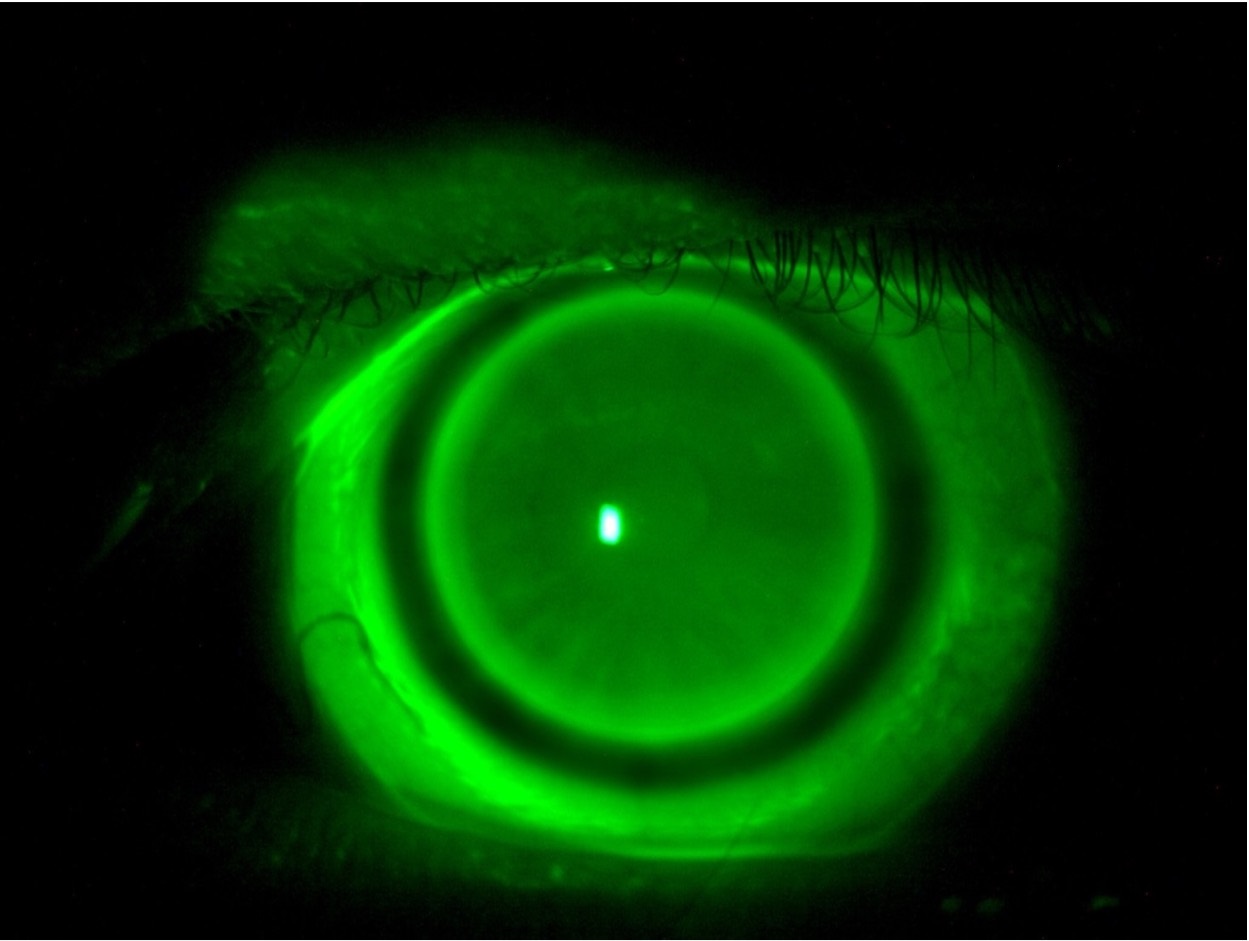 Figure 6: Fluorescein fit pattern of case 1
Figure 6: Fluorescein fit pattern of case 1
At one week follow up:
- Noticing ghosting especially in lower light.
- Feels vision is too sharp!
- O/Ref felt more comfortable and similar to specs with +0.50 R&L
- Fit, movement and comfort good
Conclusion
- Increased optic zone diameter in RE (dominant) to reduce low light issues.
BOZR Skirt Power Add Optic zone Other
R 8.1 8.4 Flat -1.50 +1.75 3.3mm Enhanced Profile
L 8.2 8.4 Flat -1.00 +1.75 3mm Enhanced Profile
- Px now gets 6/6 binoc and N5 and has comfortable vision at all times
Case #2: Myopia Management with Duette Progressive2
It should be noted that Duette lenses are off licence for myopia management and that their use falls within the clinical judgement of the practitioner.
- Seven-year-old gymnast with a history of degenerative myopia in the right eye
- Her spectacle prescription was; R -9.00 -4.00 x 020
L +1.50 -1.25 x 180
Axial length was 26.10 mm and 21.65 mm in the right and left eyes respectively.
- Due to patient’s large anisometropia and active lifestyle, her mother was interested in having her fitted with contact lenses.
- The patient was empirically fitted into a SynergEyes Duette
- RE Duette Centre Distance Progressive
- LE Duette single vision
- Empirical ordering was based on spectacle prescription, corneal topography keratometry values, horizontal visible iris, and pupillary diameter
- At the patient’s one-month follow-up, her mother reported that the patient appeared less shy and was better able to perform her gymnastics in her new contact lenses.
Case #3: Fitting an irregular cornea empirically with UltraHealth lenses3
Patient RJ was diagnosed with bilateral keratoconus in 2013. He had previously worn corneal RGPs and was unhappy with ‘the lenses falling out the whole time’ along with VAs that were variable and 6/9- at best. These lenses were found to be decentred resulting in the poor VAs and so UltraHealth was decided upon.
UltraHealth lenses are routinely fitted from a fitting set however they can be supplied empirically provided topography or pentacam can be supplied. To calculate the new prescription, we would also require either the spectacle refraction or, better still, if available, a previous rigid lens specification (including any over-refraction found).
From the Pentacam (figure 7), we have k readings and Q values of:
RE. 47.5D (7.10mm) x 49.0D (6.88mm)
Q-value @6mm was -1.03
LE. 51.6D (6.54mm) x 52.6D (6.41mm)
Q-value @6mm was -1.57
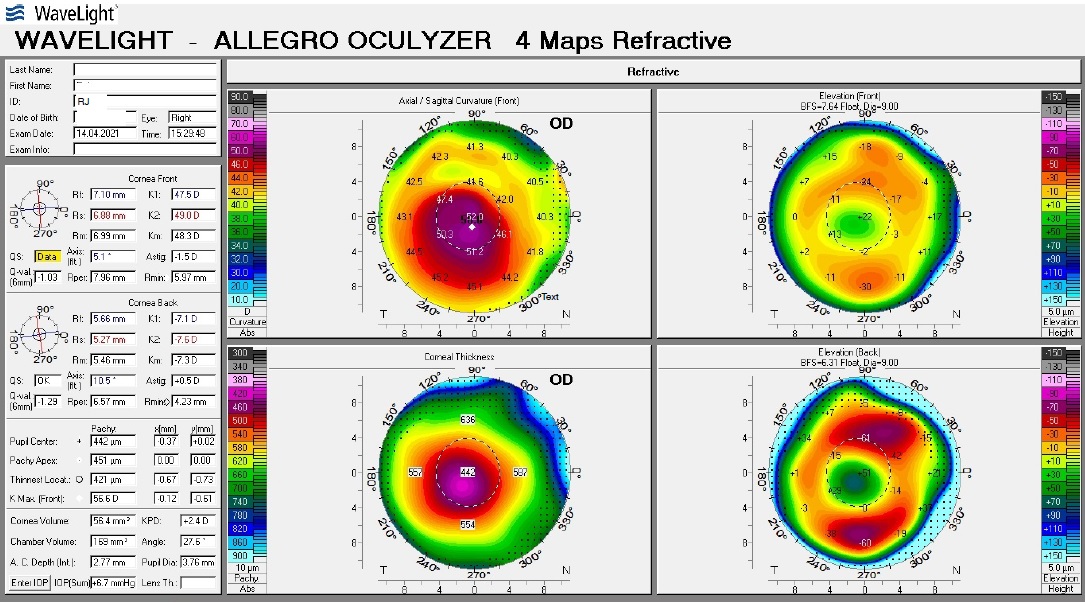 Figure 7: Pentacam data for case 3
Figure 7: Pentacam data for case 3
As the previous RGP prescription was unreliable, the practitioner put in an UltraHealth trial lenses of known power and performed an over-refraction. This also allowed opportunity for teaching A&R, saving on chair time at collection.
The BOZR of trial lenses was 6.9mm with a power of -9.00.
Over-ref; R +3.25 and L +3.00
The sag of the GP portion is calculated from the known diameter and values above to give a lens that should clear the cone. The power of that lens is calculated via the difference in radii of the two lenses taking any over-refraction into account in much the same way as when changing the fit of an RGP lens. The results were:
UltraHealth.
R 250 (vault) / 8.1M (skirt) / -5.75
L 250 (vault) / 8.1M (skirt) / -6.00
At the follow up, although the results were reasonable, the clearance was not quite enough and so the fit was changed to a 300μ vault R&L. As the design of this lens has a greater reverse geometry in the periphery, they have a slightly flatter BOZR meaning there would be an adjustment to the power to compensate for the new tear lens.
The final lenses were:
R 300 / 8.1M / -3.25
L 300 / 8.1M / -3.00
The anterior OCT (figure 8) of this lens on insertion shows a little over 150μ of clearance which will settle to around 100μ, just at the higher end of ideal. The comfort was good, and the patient achieved VAs of R 6/6+ & L 6/6+ and most importantly, consistent.
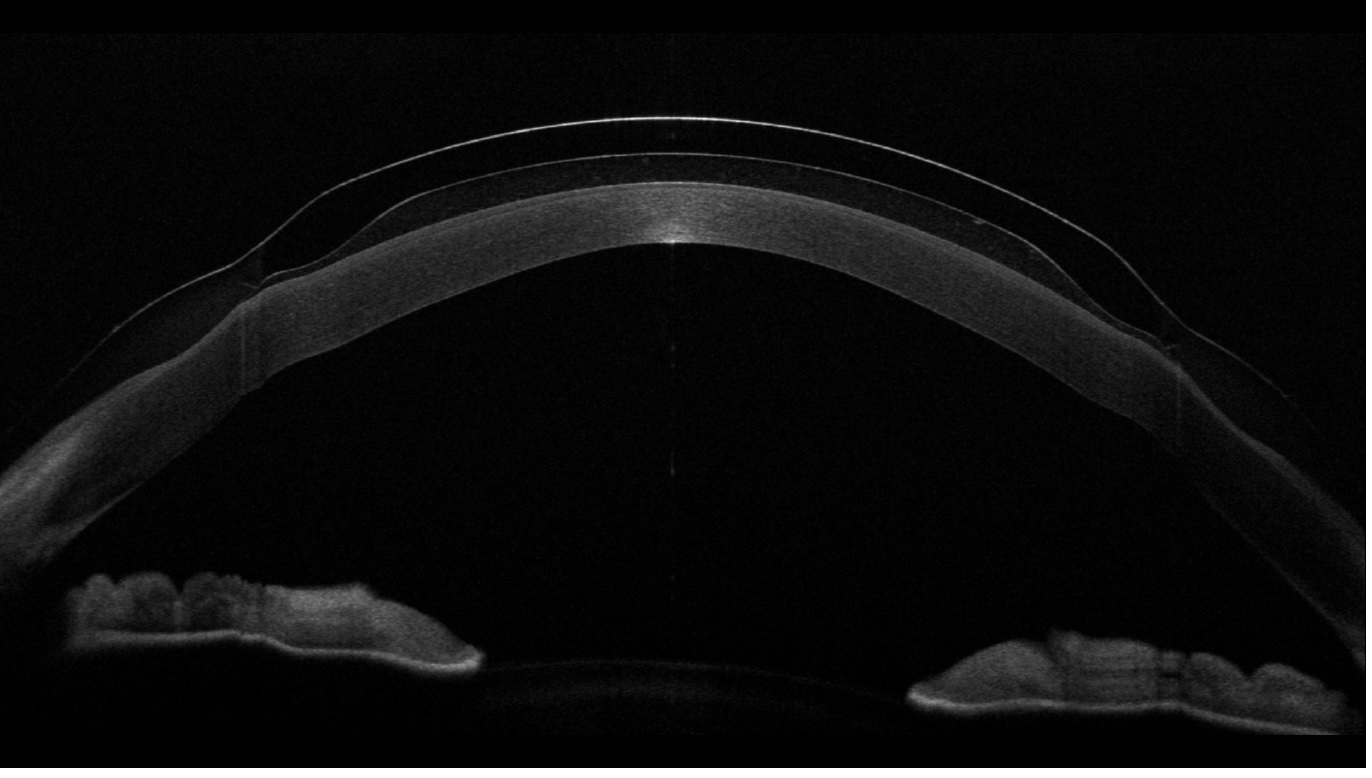 Figure 8: Anterior OCT of lens from case 3 in situ
Figure 8: Anterior OCT of lens from case 3 in situ
Conclusion
I often find a divide between my professional colleagues in their knowledge of modern hybrid lenses. Those ‘in the know’ about modern hybrid lenses find them a very useful addition to their business, for both irregular and regular corneal astigmats, in particular presbyopic astigmats. However, there is still a proportion of practitioners who maintain the mindset that these lenses are for irregular work only, or feel that the challenges of the past, relating to fragility and difficulties in fitting and handling, are still relevant today.
I hope this article may stimulate interest in a renewed look at a contact lens design with some notable advantages in a number of clinical presentations.
- Phil Thompson FBDO CL MBCLA is Professional Services Lead for Positive Impact incorporating SynergEyes UK.
References
- Trinh T, Doan OD, Ekaterina Kolozhvari MS, Rosa Lee MS, Ryan Hernandez. Evaluating the Strength of the Junction between RGP and SiHy in SynergEyes Hybrid Contact Lens. Poster, BCLA Conference, 2017.
- From a recent article in Review (June 2020) by Melanie Frogozo OD. Myopia Management in the Era of COVID-19 (http://reviewofmm.com/myopia-management-in-the-era-of-covid-19/ )
- With thanks to Cian Gildea FAOI, MBCLA, BSc. (Hons)Optom, Clinical Optometrist at The Wellington Eye Clinic, Dublin
